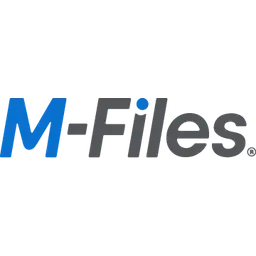In the sprawling digital jungle where documents roam wild and free, two titans stand at the forefront of the document management ecosystem: M-Files and SharePoint. Each boasts unique strengths and capabilities, yet in the quest to tame the chaos of files, folders, and data, only one can be the ultimate tool for your organization. M-Files, with its innovative approach to metadata-driven document management, offers a refreshing take on organizing and retrieving documents. SharePoint, a veteran in the field, brings its deep integration with the Microsoft ecosystem and a robust platform for collaboration. But when the dust settles, which platform will best align with your organizational needs, streamline your workflows, and enhance your team’s productivity?
M-Files | SharePoint |
|---|---|
| G2 Score – 4.3 out of 5 stars | G2 Score – 4 out of 5 stars |
| TrustRadius Score – 9.2/10 | TrustRadius Score – 7.9/10 |
Integration Capabilities: The Key to a Unified Workflow
In today’s interconnected work environment, a document management system’s ability to integrate seamlessly with existing applications and services is not just a convenience—it’s a lifeline.
M-Files: The Agile Connector
M-Files shines with its agile approach to integration, offering a unique metadata-driven system that can connect with a wide array of external databases and applications, from CRM systems to ERP solutions. This flexibility allows M-Files to serve as a central hub for all documents, regardless of their original location or format, enabling users to access and manage files through a unified interface. M-Files’ API further supports custom integration, making it adaptable to specific organizational needs.
While M-Files’ approach to integration is powerful, achieving the full potential of its capabilities can require a detailed understanding of metadata and how to effectively implement it across systems. Organizations may need to invest time in setup and training to ensure seamless integration with existing workflows.
SharePoint: The Microsoft Ecosystem Powerhouse
As a pillar of the Microsoft ecosystem, SharePoint offers unparalleled integration with Office 365 applications, facilitating a cohesive workflow for document creation, management, and collaboration. Its extensive API and developer community also support custom integrations, allowing SharePoint to be tailored to a wide variety of business processes and applications beyond the Microsoft suite.
SharePoint’s deep integration capabilities are most effectively leveraged within the Microsoft ecosystem. Organizations heavily reliant on non-Microsoft products may find integration more challenging, potentially requiring additional customization or third-party solutions to bridge the gap.
User Experience (UX) and Ease of Use: Simplifying Document Management
The intuitiveness of the platform, coupled with the ease with which users can adopt and navigate the system, plays a significant role in its overall effectiveness and the productivity of the team. A document management system that marries powerful capabilities with an intuitive interface is key to ensuring that your team can fully leverage its features without being bogged down by complexity.
M-Files: Intuitive Navigation with a Metadata Focus
M-Files brings a unique approach to document management with its metadata-driven system, which allows for intuitive categorization and retrieval of documents without the need for complex folder structures. This approach can significantly streamline how users interact with the system, making document retrieval straightforward and efficient. The platform’s user interface is designed to be clean and user-friendly, supporting quick adoption and reducing the learning curve for new users.
The strength of M-Files in terms of ease of use lies in its ability to present documents in a context that is relevant to the user, leveraging metadata to ensure that the right documents are accessible at the right time. While the concept of metadata might require an initial adjustment for users accustomed to traditional file structures, M-Files’ intuitive design and guided workflows facilitate a smooth transition.
SharePoint: Powerful but Potentially Overwhelming
SharePoint offers a robust set of features designed to support a wide range of document management, collaboration, and intranet functionalities. However, its strength as a comprehensive platform can also introduce complexity, potentially overwhelming new users. The user interface, while customizable, often requires a tailored setup to ensure it aligns with organizational workflows and user expectations.
Maximizing the potential of SharePoint typically involves a considerable investment in customization and user training. For organizations deeply entrenched in the Microsoft ecosystem, the integration with Office 365 apps can enhance the user experience by providing a layer of familiarity. Nonetheless, achieving a streamlined user experience in SharePoint may demand ongoing support from IT specialists to adapt the platform to the specific needs of the team.
Security and Compliance: The Foundation of Trust and Integrity
In today’s digital age, where data breaches are increasingly common and regulatory requirements are more stringent, the ability of a document management system to protect sensitive information and ensure adherence to legal standards is paramount. A document management system’s security features and compliance capabilities are crucial for protecting your organization’s data and meeting regulatory obligations.
M-Files: Security with a Metadata Advantage
M-Files places a strong emphasis on security, with features including encryption of data in transit and at rest, detailed access controls based on metadata, and robust audit trails. The platform’s use of metadata not only enhances document organization but also allows for precise security controls, ensuring that sensitive information is accessible only to authorized users based on context and content.
M-Files shines in its support for compliance, offering tools designed to help organizations meet various regulatory requirements with less effort. Its ability to automate records management and retention schedules, based on metadata, simplifies compliance with standards like GDPR, HIPAA, and others. M-Files also provides comprehensive audit trails, further supporting compliance efforts by documenting every interaction with the system.
SharePoint: Comprehensive Security with Broad Compliance
SharePoint, as part of the Microsoft ecosystem, benefits from Microsoft’s extensive security measures. It includes sophisticated encryption, threat management, and access control mechanisms, all designed to protect against unauthorized access and data leaks. SharePoint allows for granular permission settings, enabling administrators to finely tune access levels to sensitive documents and sites.
SharePoint excels in the area of compliance, offering a wide range of features to support organizations in meeting regulatory requirements. Its comprehensive audit capabilities, retention policies, and data loss prevention (DLP) tools make it easier for businesses to adhere to legal standards and industry regulations. SharePoint’s integration with the broader Microsoft 365 compliance center enhances its ability to manage compliance across an organization’s digital landscape.

Related: Check out our free SEO suite

Mobile Accessibility and Remote Work Support: Keeping Teams Connected Anywhere
The capacity of a document management system to provide a seamless, efficient experience across devices and to facilitate remote work is key to maintaining productivity and operational continuity.
M-Files: Seamless Access On the Go
M-Files offers a mobile app that’s designed to provide users with easy access to documents from anywhere, at any time. The app supports a range of functionalities, including document retrieval, editing, and sharing, directly from mobile devices. Its intuitive design ensures that users can stay productive even when they’re away from their desks, making it an excellent tool for teams that need to work remotely.
The strength of M-Files in supporting remote work lies in its ability to make documents accessible through a variety of devices while maintaining security and compliance. Its metadata-driven system allows users to find the documents they need quickly, regardless of where the files are stored, enhancing the efficiency of remote work. The platform’s flexibility in integrating with other business applications further supports a cohesive remote work experience.
SharePoint: Robust Features with Device Versatility
SharePoint provides users with mobile applications for iOS, Android, and Windows devices, allowing for robust document management capabilities on the go. The SharePoint mobile app enables document access, collaboration, and management functionalities, ensuring that users can remain productive regardless of their location.
As part of the Microsoft ecosystem, SharePoint integrates closely with tools like Microsoft Teams, enhancing its remote work support by facilitating communication and collaboration alongside document management. This integration allows teams to work together seamlessly, sharing and collaborating on documents directly within the context of their conversations and meetings.
Scalability and Customization: Tailoring the System to Your Evolving Needs
The scalability of a document management system, alongside its ability to be customized, ensures that the platform can grow with your organization and adapt to changing business processes and needs.
M-Files: Flexibility Through Metadata and Modular Design
M-Files is built with scalability in mind, able to accommodate growing amounts of data and an increasing number of users without compromising performance. Its architecture allows organizations to expand their document management capabilities as needed, making it a suitable option for businesses of all sizes looking to scale their operations.
One of the core strengths of M-Files is its highly customizable nature, facilitated by its use of metadata. This approach allows organizations to define unique workflows, document categorizations, and access permissions, tailored to their specific requirements. Additionally, M-Files offers a range of modules and integrations that can be added to the system to extend its functionality and better serve individual business needs.
SharePoint: Enterprise-Level Scalability with Deep Customization
SharePoint, known for its robustness, is designed to meet the demands of both small businesses and large enterprises. Its capacity to manage vast quantities of data and support a large user base makes it an ideal choice for organizations expecting to grow or scale their operations significantly.
SharePoint’s deep customization capabilities are one of its hallmark features. Through the development of custom web parts, integrations, and applications, businesses can tailor SharePoint extensively to fit their unique processes and workflows. While this level of customization offers powerful flexibility, it often requires specialized development skills and may increase the complexity of the system.
Pricing
M-Files:

SharePoint:

Conclusion
In wrapping up our comparison between M-Files and SharePoint, we’ve navigated through a series of critical considerations. Both platforms emerge as strong contenders in the document management arena, each with its unique strengths suited to different organizational needs and priorities.
M-Files distinguishes itself with its metadata-driven approach, offering intuitive navigation, intelligent version control, and automated document lifecycle management. This platform excels in providing a user-friendly experience that simplifies document management, making it particularly suitable for organizations looking for streamlined processes, ease of use, and efficient compliance with regulatory standards. M-Files’ flexibility in integration and modular design also supports scalable growth and customization, catering to businesses aiming for agility and adaptability in their document management practices.
SharePoint, on the other hand, stands out for its deep integration within the Microsoft ecosystem, comprehensive customization options, and robust security and compliance features. Its extensive capabilities make it an ideal choice for larger enterprises or organizations with complex document management needs that require a high degree of personalization. SharePoint’s scalability and powerful version control and lifecycle management tools offer a solid foundation for businesses committed to the Microsoft suite of products, despite the potential need for significant training and IT support.
Read Next:
- AWeber vs EmailOctopus: The Best Email Marketing Tool
- ActiveCampaign vs eSputnik: The Best Email Marketing Tool for 2024
- ActiveCampaign vs MailUp: The Best Email Marketing Tool for 2024
- AWeber vs Campaigner: The Best Email Marketing Tool
- ConvertKit vs MailerLite: The Best Email Marketing Tool for 2024






















Comments are closed.